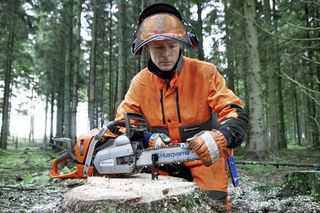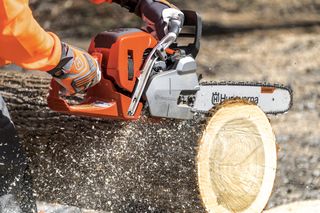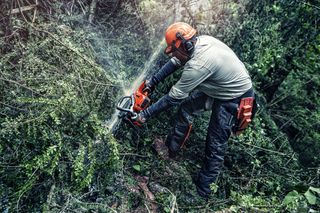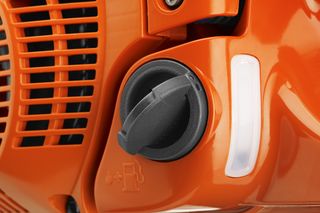
How To Make Tree Felling Notches & Hinges with a Chainsaw
Felling a tree requires much more than simply whipping out your chainsaw and getting to work on it. Depending on its age, fibre density, whether it’s leaning a certain way, height, the way the branches fall and even the weather conditions on the day; making the right cut in the right place makes all the difference. The easiest method is to fell trees in the direction they would naturally fall if blown over by the wind. Of course, if this is into a building or road, then it’s not always a viable option. Ultimately, the surrounding terrain and any obstacles in the way will determine which type of cut is best.
Why Put a Notch into a Tree?
Notches are used to help a tree fall in your chosen direction. By removing a small notch out of the trunk and creating a hinge, you prevent the tree from falling in any direction, and instead, force it to land where you want it to.
Think of it this way. If you have a tree that is perfectly straight, no leaning or heaviness and you cut right through in one fell swoop, where it lands will be luck of the draw. A directional notch and hinge will not only help it fall where you want it to, but also make it much safer too.

What Are the Different Types of Directional Notches?
Typically, the majority of directional notches are open-faced. Depending on the lay of the land, you’ll either use an open-faced notch, a conventional notch or a Humboldt notch. Of these, the open-faced directional notch is the easiest.
Open-Faced Directional Notch
- The hinge stays intact until the tree is on the ground.
- Leaves behind reasonably large stumps
The preferred choice when working with trees on slopes when you want the hinge to remain intact for a longer period of time. Consists of a large opening angle (between 70 - 90 degrees) with the bottom cut angled away from the top and felling cut.
Conventional Directional Notch
- Creates a low stump height, good for split-prone trees.
- High position of felling cut can increase the likelihood of splits.
Often used for felling medium to tall trees on level ground when a more precise direction of fall is required. Commonly uses a 45-55 degree opening angle.
Humboldt Directional Notch
- Low stump height on slopes and steep terrain.
- Higher stump heights on flat or level ground.
This method is best used on steep slopes and with very tall trees, along with tree species that are prone to splitting when being felled. Typically uses an opening angle of 45 degrees minimum.
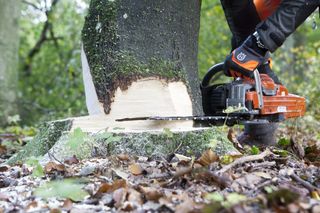
How To Make a Notch & Hinge With a Chainsaw
The easiest way to create notches and hinges on all types of tree is with a chainsaw. The Husqvarna 550XP Mark II and the 455 Rancher are two fantastic examples of professional-grade chainsaws ideal for felling and cutting tasks on a daily basis.
Open-Faced Notch
- Begin by removing any root protrusions around the base of the tree and then remove the bark from where you intend on making your felling and directional cuts. Then decide how high the stump will be.
- Lean against the trunk with your left shoulder touching it and your left knee on the ground. Create a stump height mark with your chainsaw.
- Make your first cut downwards at an angle of approximately 70 degrees and stop when you have reached ⅓ of the diameter of the tree.
- For the bottom cut, cut upwards at a 20-degree angle and stop once you meet the upper cut. This should give you a 90-degree notch opening.
- Locate the notch angle and then on the opposite side of the tree, place a marker in line with this.
- Cutting flat along the horizontal plane, cut toward the notch angle. Stop when you’ve created a hinge that’s approximately 1/10 the diameter of the trunk.
Conventional Notch - Top Cut
- Begin by removing any root protrusions around the base of the tree and then remove the bark from where you intend on making your felling and directional cuts.
- Decide how high the stump will be, then lean against the trunk with your left shoulder touching it and your left knee on the ground. Create a stump height mark with your chainsaw.
- Using the chainsaw felling line-marking, angle your chainsaw to where you want the tree to fall.
- Using full throttle at an angle of 60 to 80 degrees, cut inwards to approximately 25% of the diameter of the tree. Ensure you maintain the correct angle and position throughout this cut.
- Next, create your bottom cut by holding the chainsaw horizontally and sawing inwards to meet the top cut. The two cuts need to be precise and meet exactly on the angle, so avoid going too deep too quickly.
- Lastly, make your felling cut. This should be in line with or just slightly above the line of the bottom cut on the opposite side of the tree.
Humboldt Notch
- Start by cutting away any root protrusions around the base of the tree and then remove the bark from where you intend on making your felling and directional cuts
- Decide at what height the stump will be, then create a stump height marking with your chainsaw. With a Humboldt notch, it’s best to make the top cut first.
- Using full throttle and entering horizontally, cut inwards to approximately 25% of the diameter of the tree.
- Next, create your Humboldt cut by cutting upwards at a 45-degree angle until you meet the uppercut. Make sure you don’t overcut or go too deep, they should line up perfectly.
- Lastly, cut horizontally on the opposite side of the trunk and at around 1 inch above the angle of the Humboldt notch. This should stop at the point where the hinge is roughly 1/10 of the trunk diameter.

Get Started with Better Notches, Hinges & Felling
Whether you prefer the Humboldt notch, the Open-Faced notch, or are all about the Conventional notch - having the best tools on hand goes a long way to achieving the desired outcome. For more than 60 years, Husqvarna has been innovating the world of chainsaws, bringing advanced design and technology to the forefront.
Keeping your chainsaw air filters in tip-top condition, knowing how to sharpen your chainsaw chain, making use of the best PPE available to you and knowing which cuts to use in every type of situation will have you felling like a pro in next to no time.
Not sure which saw is best for your needs? Visit your local Husqvarna dealer today. Want to learn more about different notches? Check out our Chainsaw Academy, it’s loaded with handy tips and tricks.
